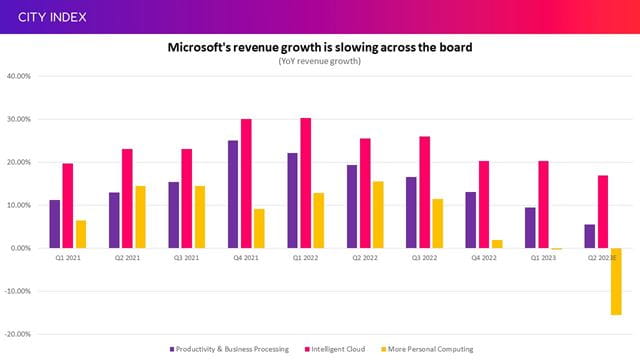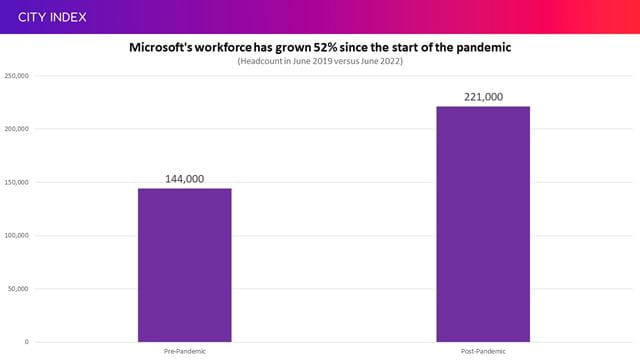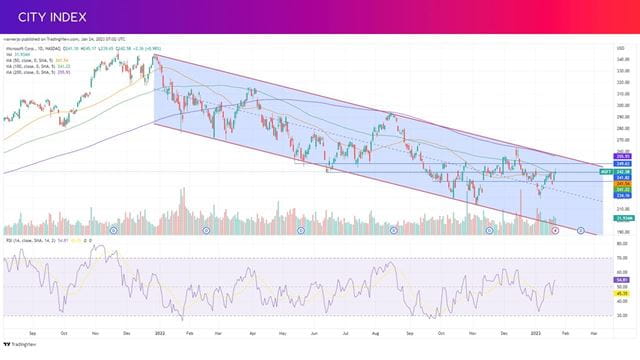
When will Microsoft release Q2 earnings?
Microsoft is scheduled to publish earnings covering the second quarter of its financial year, covering the three months to the end of December 2022, after US markets close on Tuesday January 24. A live webcast will happen on the same day at 1430 PT.
That will kick-off earnings season for Big Tech stocks, with the likes of Meta, Alphabet and Apple to follow in the first two days of February. You can find out what to expect from the sector in our Big Tech Earnings Preview.
Microsoft Q2 earnings consensus
Wall Street forecasts that Microsoft will report a 2.4% year-on-year increase in revenue to $52.97 billion in the second quarter, while EPS is expected to drop 6.9% to $2.31.
Microsoft Q2 earnings preview
Microsoft is expected to report its slowest topline growth in over five years and the first drop in earnings in over eight when it releases second quarter results.
Sales growth is slowing across the board. Growth peaked in mid-2021 for its cloud computing and software divisions but both have been suffering a slowdown since then, while its hardware unit responsible for the likes of computers and games consoles is forecast to fall for a second consecutive quarter. That shows that demand for everything is waning.

(Source: Bloomberg)
‘We’re living through times of significant change, and as I meet with customers and partners, a few things are clear. First, as we saw customers accelerate their digital spend during the pandemic, we’re now seeing them optimize their digital spend to do more with less. We’re also seeing organizations in every industry and geography exercise caution as some parts of the world are in a recession and other parts are anticipating one,’ Microsoft said in a blog post on January 18.
More Personal Computing will be the biggest drag as sales of its devices falls by a double-digit percentage, which in turn will lead to similar reduction in demand for its Windows operating system. That will also knock sales of its suite of Office products within its Productivity & Business Processes division, which will also suffer thanks to lower revenue from its job-focused social media platform LinkedIn. The fact both Amazon Web Services and Microsoft’s cloud computing units both missed expectations in the last quarter and are set to see things stall even further this quarter suggests the entire industry is cooling down as businesses delay investment and pullback on spending in response to the tough macroeconomic conditions.
Earnings are set to fall as costs continue to rise at a faster pace than revenue, with operating expenses forecast to be up 3.1% from last year this quarter to squeeze its margin.
Microsoft cuts 10,000 jobs
In response, Microsoft has announced it is preparing to cut 10,000 jobs by the end of March, representing just under 5% of its workforce. This will cost the company around $1.2 billion in charges in the second quarter that will consist of severance costs and lease consolidation charges as well as reflect changes within its hardware division.
That was a slightly shallower cut than what was anticipated after Sky News reported it was looking to cut over 11,000 workers.
Microsoft has been on a hiring spree since the start of the pandemic, with its workforce having grown over 50% by June 2022. A round of layoffs would make it the latest major tech firm to try to cut some fat in the tough economic climate, following the likes of Meta, Amazon and Salesforce. Microsoft has said it will continue to recruit in ‘key strategic areas’ and described the decision as ‘difficult, but necessary’.

(Source: Company reports)
‘When I think about this moment in time, the start of 2023, it’s showtime – for our industry and for Microsoft. As a company, our success must be aligned to the world’s success. That means every one of us and every team across the company must raise the bar and perform better than the competition to deliver meaningful innovation that customers, communities, and countries can truly benefit from. If we deliver on this, we will emerge stronger and thrive long into the future; it’s as simple as that,’ said CEO Satya Nadella.
Microsoft and ChatGPT
Microsoft has announced it is developing its partnership with Open AI, the company behind the AI-driven chatboth ChatGPT, which has been grabbing headlines in recent weeks with some touting it as a major development for artificial intelligence.
Microsoft already owns a stake in OpenAI after investing $1 billion back in 2019 but the latest expansion of the partnership will see the Big Tech giant make a multi-billion investment into the company. That is all we know about the financial side of the deal, but news site Semafor reported earlier this month that Microsoft was considering ploughing another $10 billion into the company as part of a new funding round that would value OpenAI at $29 billion.
‘We formed our partnership with OpenAI around a shared ambition to responsibly advance cutting-edge AI research and democratize AI as a new technology platform,’ said Microsoft CEO Satya Nadella. ‘In this next phase of our partnership, developers and organizations across industries will have access to the best AI infrastructure, models, and toolchain with Azure to build and run their applications.’
ChatGTP is currently available to those using Microsoft’s Azure OpenAI service but is now being made generally available in a move that could see a flood of new users try out the service. Citigroup has said the chatbot, which interacts in a conversational manner and is able to provide detailed responses with minimal human direction, could be a new ‘killer data centre AI application’ that marks a ‘significant breakthrough’ that can lend itself to numerous applications.
For example, there has been speculation that Microsoft will use ChatGPT to thrust its search engine Bing into the modern era, which has some investors in Alphabet worried that its monopoly over search could be under threat from any breakthrough.
Microsoft and OpenAI are working together but are independently looking for ways that can be monetised. This next stage of the partnership will see Microsoft supply the supercomputing power needed to take OpenAI’s research to the next level and see OpenAI’s services rolled-out to Microsoft clients. Microsoft has also locked-in exclusivity when it comes to providing the cloud computing services to what could be one of the hottest AI startups right now.
OpenAI is small but could grow rapidly, even in the current environment. A recent pitch seen by the media suggests the company expects to make around $200 million in annual revenue before growing it to $1 billion by 2024. Further reports have surfaced suggesting it is to launch a pro version for $42 per month. ChatGPT is already thought to have breached the 1 million-user mark before the end of 2022 and, at that reported price, it would need under 24 million of them to hit that $1 billion sales target.
Microsoft’s decision to invest what could be a significant sum into OpenAI at the same time as cutting 5% of workforce shows that the industry needs to reallocate resources by downsizing bloated divisions working on the operations that drive the business today while simultaneously investing in areas that can provide the next era of growth.
Is Microsoft stock overvalued?
Microsoft shares have shed over 30% of their value since peaking back in late 2021 but the stock still trades at a price-to-earnings ratio of around 23.2x at present. Like most of Big Tech, the explosion in value during the pandemic has left a lot of room for it to deflate now that times are much tougher, but Microsoft’s valuation is still lofty considering most of its Big Tech rivals are trading at lower multiples while the S&P 500 currently boasts a ratio of 19.4x. That suggests Microsoft could still be expensive at current levels.
Still, brokers believe that the selloff seen over the past year has been overdone considering the average target price among the 43 brokers that cover the stock sits at over $293, implying there is over 24% potential upside from current levels. However, it is worth noting that these targets have been slashed considering the average sat at over $327 just three months ago.
With that in mind, Guggenheim recently downgraded Microsoft to Sell from Neutral after setting its target price at just $212, which is some 11% below current levels. The broker, which is an outlier considering it is the only one with a Sell rating, has turned cautious on an array of software companies in the current environment. ‘We’re in a prolonged macro slowdown and no one is immune,’ said analyst John DiFucci. ‘While most investors see Microsoft as a large stable business that can weather any storm, it does have vulnerabilities, some of which could be exacerbated by this macro slowdown’.
Where next for MSFT stock?
Microsoft shares have fallen almost 30% since peaking back in late 2021, with the downtrend still firmly in play.
The stock has gained ground over the past two weeks and the fact it recaptured the June 202 low as well as both the 50-day and 100-day moving averages yesterday suggests it is finding some momentum – although it has a long way to go before convincing the markets that it has broken out of the downtrend.
It can now try to move toward the level of support seen between May and July 2022 at $249.60 before eyeing the 200-day moving average that is tracking the ceiling of the downtrend.
On the downside, we could see the stock find some support at around the $234 level should it come under any renewed pressure. The 2023-low of $222.30 hit in early January comes back onto the radar after that, with the near two-year low of $214.25 seen last November still in play. The stock could head even lower if it falls back toward the supportive line of the downtrend.

Take advantage of extended hours trading
Microsoft and other Big Tech stocks release earnings after US markets close and this means most must wait until they reopen the following day before being able to trade. But by then, the news has already been digested and the instant reaction in share price has happened in after-hours trading. To react immediately, traders should take their positions in pre-and post-market sessions.
With this in mind, you can take advantage of our service that allows you to trade Microsoft and other Big Tech stocks using our extended hours offering.
While trading before and after hours creates opportunities for traders, it also creates risk, particularly due to the lower liquidity levels. Find out more about Extended Hours Trading.
How to trade Microsoft stock
You can trade Microsoft shares with City Index in just four easy steps:
- Open a City Index account, or log-in if you’re already a customer.
- Search for ‘Microsoft’ in our award-winning platform
- Choose your position and size, and your stop and limit levels
- Place the trade
Or you can practice trading risk-free by signing up for our Demo Trading Account.










